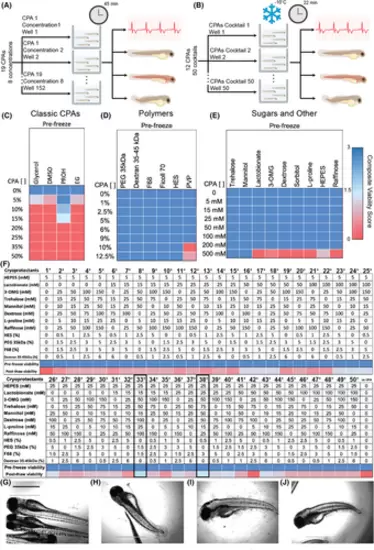Fig. 1
- ID
- ZDB-FIG-240109-2
- Publication
- Da Silveira Cavalcante et al., 2023 - Zebrafish as a high throughput model for organ preservation and transplantation research
- Other Figures
- All Figure Page
- Back to All Figure Page
|
Individual CPA toxicity assay (A) and identification of best performing external CPAs cocktail capable of retaining larvae viability after 22 min of storage at −10°C when immersed in CPAs (B). Larvae viability was determined by quantifying heart rate, dehydration, blood circulation, and fish morphology and reported as the External Composite Viability Score (CVSExt). (C–E) Four classic CPAs, six polymers, seven sugars, and two other components (total of 19) were tested to determine their individual toxicity prefreeze at eight different concentrations by incubating larvae for 45 min (n = 4 animals per CPAs concentration). (F) Twelve CPAs, from the previously tested nineteen, were arranged in a L50 Taguchi experimental design and tested at different concentrations (7) yielding 50 CPAs cocktails (n = 4 animals per CPAs cocktail). Prefreeze toxicity was determined after 30 min of incubation, with CPAs cocktails 33+ and 38+ resulting in the best larvae outcomes as determined by above threshold (>1.5) post-thaw CVSExt (1.75 and 1.625 respectively). Storage with above-threshold CPAs cocktails resulted in post-thaw retention of larva morphology (G) compared to untreated or unfrozen larvae (H), whereas storage without CPAs (I) or below the-threshold CPAs (J) resulted in significant loss of morphology and overall embryo integrity. Scale bar 1000 um. |

